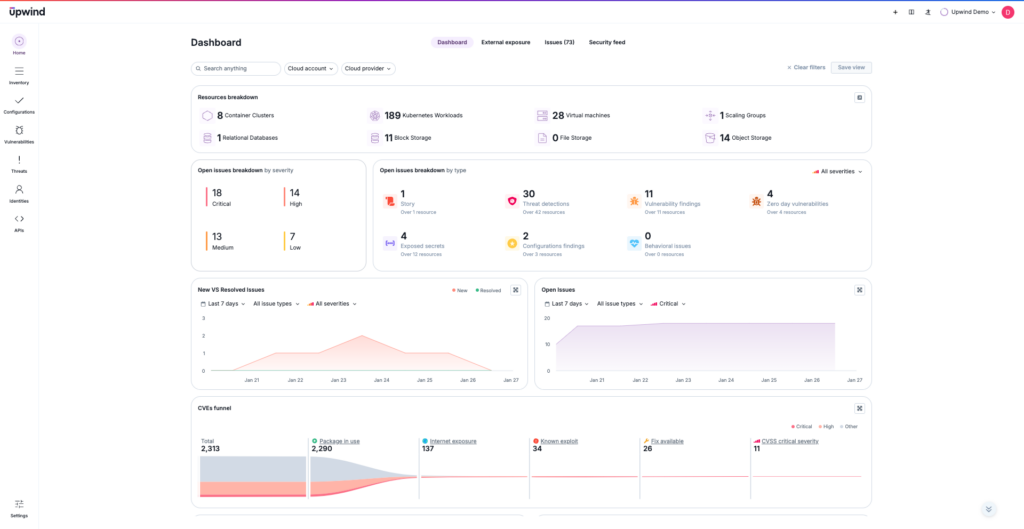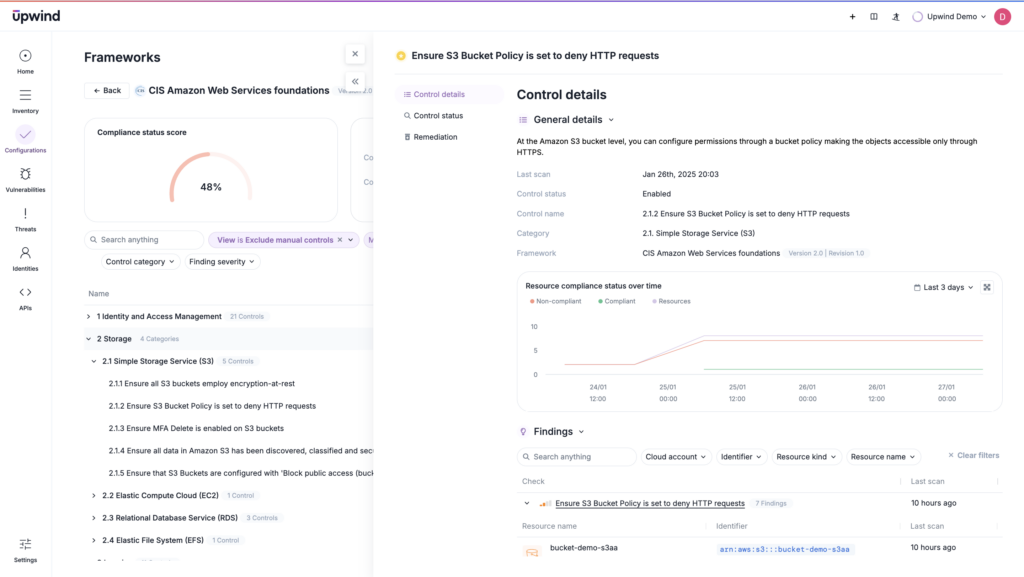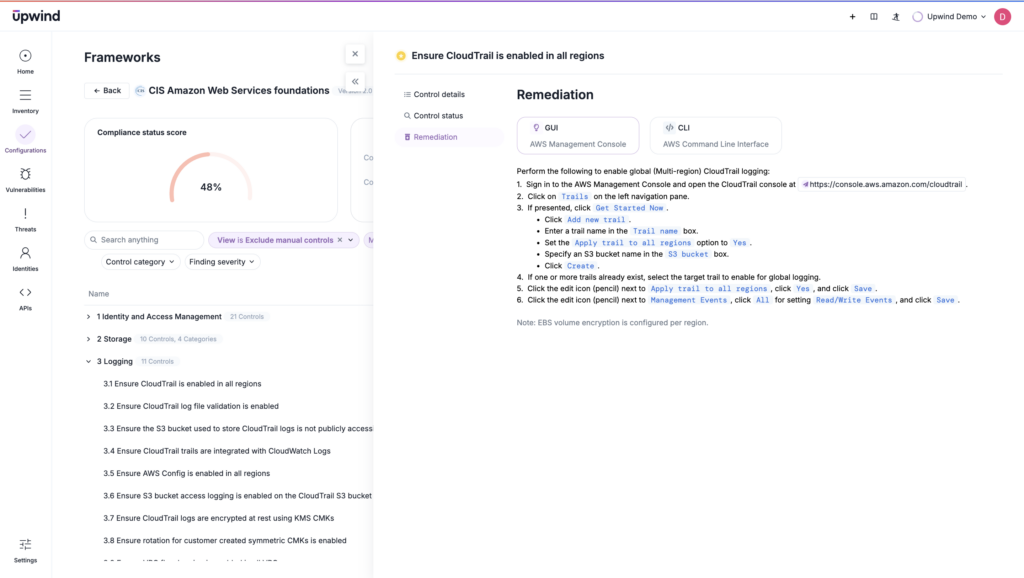
Companies voluntarily align with frameworks like CIS Benchmarks to meet customer expectations, ensure audit readiness, and build trust. These Benchmarks provide prescriptive guidelines for hardening systems, but their adoption isn’t just about ticking boxes — it’s about proving that security controls meet the highest standards in increasingly competitive and regulated markets.
Aligning with CIS Benchmarks presents significant technical challenges. Organizations often struggle with automating configuration checks, addressing drift in hybrid and multi-cloud environments, and ensuring consistent enforcement across diverse systems. This article will explore what CIS Benchmarks are, why they matter, and how to overcome implementation challenges with scalable, efficient solutions that secure tech environments without compromising agility.
A Refresher: Understanding CIS Security Standards
CIS Benchmarks are a set of globally recognized best practices for securing IT systems and apps. Developed by the non-profit Center for Internet Security in 2000, they helped offer direction in an era of increasing cybersecurity threats, providing clear, actionable guidelines to help organizations enhance their cybersecurity posture, reduce vulnerabilities, and align with industry standards for security.
“The data proves that things are getting worse: the number of security vulnerabilities, breaches, and disasters is increasing over time. Even as we learn more about security…we build things with less security.”
— Author and cryptographer Bruce Schneier in his 2000 book Secrets and Lies: Security in a Networked World
It was a time of reckoning, and most organizations were left without a clear path to secure their increasingly complicated and diverse ecosystems.
Enter the CIS Benchmarks, designed to cover the entirety of organizational IT security. Today, the Benchmarks offer practices to handle everything from operating systems and network devices to cloud platforms and containerized environments. And they’re highly detailed, specifying configurations for password policies, file permissions, network settings, and more.

Ultimately, the Benchmarks were welcomed by organizations eager for a roadmap for securing their complex ecosystems. However, aligning with CIS Benchmarks went beyond simply applying recommended settings; it came with new challenges. Today, teams must maintain standards across dynamic, multi-cloud environments where systems are frequently spun up, modified, or decommissioned quickly. That’s led to challenges including:
- Managing multiple tools to coordinate environments and layers of security and understanding the gaps between them
- Finding balance in adopting automation, which adds efficiencies but requires human oversight
- Managing drift detection — the identification of settings that gradually or suddenly deviate from the standard due to changes, mismanagement, or lack of oversight.
The effective adoption of CIS Benchmarks requires not just implementation but also continuous monitoring and validation to ensure sustained alignment.
Runtime and Container Scanning with Upwind
Upwind offers runtime-powered container scanning features so you get real-time threat detection, contextualized analysis, remediation, and root cause analysis that’s 10X faster than traditional methods.
Essential CIS Benchmark Categories
Though challenges remain in implementation, the comprehensive approach of the CIS Benchmarks makes them an enduring go-to for teams looking for:
- Actionable advice that includes technical settings. Compliance frameworks typically prescribe outcomes but don’t include directives like configurations. CIS Benchmarks give teams settings they can apply immediately for simple implementation.
- Benchmarks that span environments. The CIS Benchmarks span operating systems (e.g., Windows, Linux), cloud services (e.g., AWS, Azure), and networking devices.
- Guidance unrelated to industry. Industry-agnostic settings give CIS Benchmarks a universality that other regulatory frameworks lack.
- A step leading to compliance. While CIS Benchmarks are not regulatory, their guidance often helps with requirements related to regulations like PCI DSS or HIPAA compliance.
- Community support. CIS Benchmarks are developed through collaboration across industries, government, and academia. They include shared documentation and expertise and are regularly updated.
Part of their universality is that CIS Benchmarks are divided into specific categories of infrastructure components to provide actionable security guidelines for various IT systems and environments. Here’s an overview of the areas covered:
Operating System Controls
Operating systems are foundational to all IT environments, and misconfigurations or gaps at the OS level can create significant vulnerabilities. CIS Benchmarks for operating systems, such as Windows Server or Linux distributions, include guidelines for securing user authentication, managing file permissions, disabling unnecessary services that skilled hackers covertly exploit, and configuring system logging.
Cloud Platform Security
Cloud environments introduce unique security challenges, such as shared infrastructure and ephemeral workloads. CIS Benchmarks for cloud platforms like AWS, Azure, and Google Cloud provide recommendations for securing access controls, monitoring API usage, encrypting sensitive data, and ensuring proper configuration of storage services. By addressing the complexities of multi-cloud setups, these Benchmarks help reduce unmitigated cloud vulnerabilities.
Network Devices
Network devices, such as routers, firewalls, and switches, are critical in filtering traffic, segmenting networks, and enforcing access controls to prevent unauthorized communication and lateral movement. CIS Benchmarks address specific configurations for these devices, such as disabling unused ports, enforcing secure management protocols like SSH over Telnet, and updating firmware regularly.
Aligning with these standards is particularly challenging in environments with legacy devices or diverse vendors, where consistency in configurations and automated compliance checks are often lacking.
Application Security
Applications are among the most exposed layers of an organization’s attack surface, often targeted for common web app vulnerabilities like SQL injection, cross-site scripting (XSS), and insecure APIs. CIS Benchmarks for application security go beyond basic recommendations, providing guidelines for secure default configurations, strict authentication protocols, and robust logging practices.
Alignment here can be tough in fast-moving development environments where agile DevOps practices dominate. Drift in configurations, outdated dependencies, or unvetted third-party libraries often undermine benchmark compliance.
Mobile Device Protection
CIS Benchmarks for mobile devices emphasize securing endpoints through encryption, enforcing strong authentication policies, and restricting access to sensitive corporate data.
The challenge lies in achieving consistency across a diverse array of devices and operating systems, such as iOS and Android, while maintaining a consistent user experience. Misaligned policies or reliance on outdated mobile device management (MDM) tools often lead to gaps in compliance.
CIS Security Levels Explained
While CIS Benchmarks provide guidance for securing different components of systems, the CIS security levels further refine this approach by offering tiered configurations specific to an organization’s own security requirements and operational capabilities.
CIS splits its Benchmarks into levels to accommodate the needs of companies’ unique risk profiles so they’ll achieve a balance of security and functionality. Here’s what it looks like:
| Security Level | Description | Example Recommendations | Use Cases |
| Level 1: Baseline Security | Focuses on essential security configurations to protect against common threats while maintaining operational functionality | Enforcing password policies, disabling unused services, configuring basic logging | Best for general-purpose systems where ease of use and minimal impact on functionality are priorities |
| Level 2: Enhanced Security | Includes stricter configurations that provide additional protection against sophisticated attacks | Advanced logging, stricter access controls, tighter encryption settings | Best for environments handling sensitive data, such as financial systems or healthcare records |
| Defense Level | Designed to meet the rigorous standards of the U.S. Department of Defense (DoD). Security Technical Implementation Guides (STIGs) provide additional requirements on top of Levels 1 and 2. | Compliance with military-grade standards, such as advanced network segmentation, system hardening, and continuous monitoring | Used in government or defense-related environments where compliance with DoD standards is mandatory |
Each of these levels is not a one-size-fits-all solution but a framework for decision-making.
For instance, while Level 1 provides a solid foundation for security, simply meeting baseline requirements won’t eliminate more sophisticated attack vectors.
In the current threat landscape, Level 1 protections like basic password policies are often considered the bare minimum. Despite limitations, teams may still struggle to reconcile these configurations with business operations and user friction.
At Level 2, teams see additional struggles in balancing operational efficiency with security. The advanced logging and multi-factor authentication (MFA) requirements, for example, can create difficulty in practical workflows and system performance. And while stricter encryption adds extra protection, it can also increase overhead and degrade system performance.
There isn’t a perfect solution. However, for those with higher security risks, some business areas might be identified as requiring Level 2 protections, while those with lower risk profiles can be assigned to meet Level 1 Benchmarks for a better balance in operational efficiency and security.
For those requiring military-grade protection, security benefits will mean increased resources, technology, and staff. They might require a re-architecture of critical systems and networks. The payoff? Intellectual property and classified information that meets the highest Benchmarks for protection.
No single level of security is sufficient on its own; these flexible levels are just part of an overall strategy that can include Benchmarks as well as other security tools, frameworks, and organizational requirements.
Common CIS Implementation Challenges
After determining the components and levels of security that work across organizational silos and assets, implementation poses another hurdle. After all, teams will need to ensure the effective and consistent application of CIS Benchmarks at scale on a continuing basis. Though CIS Benchmarks can be simple to apply, implementing an overall strategy across assets, with multiple best practices, involves a multi-step process:
Resource Allocation
Implementing CIS Benchmarks requires dedicated resources, both in terms of personnel and tooling. Security teams must:
- Gain visibility into existing configurations
- Map them against Benchmarks
- Implement necessary changes
This can be particularly burdensome for smaller teams already stretched thin by day-to-day incident response and operational demands.
The challenge extends beyond initial implementation — maintaining alignment with CIS Benchmarks requires ongoing monitoring, validation, and remediation efforts. Without sufficient investment in automation tools or specialized expertise, organizations risk falling behind as configurations drift or new vulnerabilities emerge.
Technical Complexity
Alignment with CIS Benchmarks often requires deep system-level changes. Those can include:
- Adjusting kernel parameters on Linux systems
- Applying granular IAM permissions
- Configuring network device logs for specific retention policies
These configurations might vary significantly across environments, especially in hybrid setups where on-premises systems differ from cloud-native infrastructure. At the same time, misinterpreting Benchmarks or improper execution of changes can lead to misconfigurations that weaken security or disrupt critical services.
Enterprise Scaling
Scaling CIS Benchmarks across large, distributed environments is a major hurdle for teams. Applying Benchmarks consistently across thousands of servers, containers, and applications is a time-intensive process, especially in dynamic multi-cloud environments.
Compounding this issue is the challenge of integrating CIS recommendations into existing workflows, such as CI/CD pipelines or container orchestration platforms like Kubernetes. Without centralized management tools such as a CNAPP, scaling efforts can lead to inconsistencies, where some systems meet the standards while others fall short.
Building an Effective CIS Program
So, what do the basics of building a CIS benchmark program entail? Some basics will apply to all organizations.
Step 1: Define a Team Structure
An effective CIS program begins with assembling a dedicated team that spans security, operations, and compliance roles. This cross-functional team ensures that responsibilities are clearly defined to avoid gaps in implementation or oversight.
- Security leads: Focus on aligning configurations with CIS guidelines and managing drift detection.
- Operations teams: Handle the application of Benchmarks across on-premises, cloud, and hybrid systems to ensure uniformity.
- Compliance specialists: Monitor regulatory alignment so that CIS Benchmarks intersect effectively with regulatory frameworks like GDPR or SOC 2.
A well-defined team structure ensures the organization has both adequate expertise and accountability to manage the complexities of implementing CIS recommendations.
Step 2: Develop a Repeatable Process
Process development is crucial for scaling CIS Benchmark implementation across dynamic environments. A repeatable workflow reduces errors and ensures consistency when new systems are introduced or updated.
- Step 1: Conducting an initial gap analysis to identify deviations from CIS standards in existing configurations.
- Step 2: Prioritizing fixes based on risk impact, addressing critical misconfigurations first.
- Step 3: Establishing change control processes to ensure new deployments adhere to Benchmarks from the start.
Standardizing these processes helps teams avoid the pitfalls of ad hoc implementations.
Step 3: Integrate Tools for Automation and Monitoring
Integrating tools that automate the application, monitoring, and remediation of CIS Benchmarks is essential for efficiency, bearing in mind the complexity and scale of modern IT environments.
- Configuration monitoring: Tools should continuously check for drift, flagging deviations from CIS standards in real time.

- Remediation recommendations: Solutions that automatically recommend fixes, such as locking down exposed ports or enforcing password policies, streamline the alignment process. Tools that can triage vulnerabilities or gaps based on severity are also recommended.

- Centralized visibility: Dashboards that track assets across on-prem, hybrid, and multi-cloud environments help avoid neglecting systems.
Consider tools that offer an overview of all types of assets in an organization to avoid gaps.
By automating repetitive tasks and consolidating visibility, organizations can focus their efforts on more strategic security initiatives.
Step 4: Measure Success with Audits and Reviews
To make sure the program remains effective over time, conduct regular audits and reviews. These assessments validate adherence to CIS Benchmarks while identifying areas for optimization.
- Internal audits: Testing systems against CIS Benchmarks, validating compliance, and identifying gaps.
- External audits: Using third-party assessments to ensure unbiased validation of the program.
- Feedback loops: Incorporating findings into process refinements, ensuring continuous improvement.
Enhancing CIS Security with Upwind
Aligning with CIS Benchmarks can be daunting in today’s complex cloud and hybrid environments, where dynamic resources, multi-cloud setups, and ephemeral workloads create constant challenges. Upwind’s Cloud-Native Application Protection Platform (CNAPP) directly addresses these hurdles. Upwind continuously scans your environment to flag deviations from CIS Benchmarks in real time, like insecure container images or improper IAM permissions. Automated fixes and prioritized misconfiguration alerts streamline alignment.
Upwind also leverages runtime context, identifying which misconfigurations correlate with other risk findings, such as vulnerabilities and threats. This helps teams prioritize misconfigurations that pose immediate risks and fuels a more proactive security practice. It’s all part of how a comprehensive, runtime-focused CNAPP can make keeping up with Benchmarks simple. Want to see how? Get a demo here.
Frequently Asked Questions
What’s the difference between CIS and NIST frameworks?
CIS Benchmarks are prescriptive guidelines for securing specific systems and platforms, while NIST frameworks, like NIST Cybersecurity Framework (CSF), provide high-level, flexible risk management strategies. What does that mean? With NIST, teams are looking at a big-picture strategy for handling cybersecurity. It helps them figure out how to assess risks, decide what needs protecting, and respond to incidents.
NIST is not so much about telling organizations exactly how to secure every system, but rather about offering a flexible approach to managing risks based on what makes sense for an organization’s level of maturity.
CIS is focused on actionable configurations, with definitive actions teams can take, like exactly how to configure a firewall or set up a server. If NIST is about “how to think about security,” CIS Benchmarks are about “what to do about security.”
How often should CIS controls be reviewed?
CIS controls should be reviewed continuously to ensure they remain effective as environments evolve. At a minimum, formal reviews should be conducted quarterly or after significant system changes, such as updates, new deployments, or policy revisions.
Can CIS Benchmarks be automated?
Yes, to a great extent, CIS Benchmarks can be automated. That includes:
- Continuous monitoring of configurations (handled by CSPM tools or CNAPP tools like Upwind with CSPM capabilities). This includes automating password policies, access controls, service configurations, and logging settings.
- Continuous vulnerability detection. Tools like runtime-powered CNAPPs can monitor runtimes in real time to identify and remediate issues like unnecessary open ports, weak authentication protocols, and other runtime configuration issues that can threaten alignment with CIS Benchmarks. They also offer automated remediation.
- Infrastructure as Code (IaC) compliance automation. CNAPPs can integrate with IaC tools to ensure that configurations applied in cloud environments follow CIS Benchmarks. That automation happens as infrastructure is deployed, reducing the need for post-deployment audits.
- Incorporating findings into the CI/CD Pipeline. Capabilities like Upwind’s Shift Left can automate security measures earlier in the process, like scanning code for vulnerabilities to make sure cloud infrastructure is securely configured before it is deployed and that CIS Benchmarks are applied at the beginning of the infrastructure lifecycle.
- Automated security alerts and compliance reporting. Automated reporting tools within CSPM and CNAPP platforms let teams generate compliance reports that reflect their adherence to CIS Benchmarks. These tools also send real-time alerts when a system configuration drifts or when vulnerabilities are detected.
Which CIS Level is right for my organization?
Choose Level 1 for baseline security with minimal impact on functionality, ideal for most environments. Opt for Level 2 for enhanced security in high-risk systems handling sensitive data. STIG profiles are suited for organizations with strict regulatory requirements, such as defense or government sectors.
However, remember that organizations can apply different controls to different departments and silos within their organization to balance operations with security best.
How do you maintain CIS compliance in the cloud?
Maintaining CIS compliance in the cloud means proactively approaching security. At a minimum, teams will need to automate checks, monitor configurations, and promptly address deviations. The process looks like this:
- Automate configuration checks: Use tools like CSPM and CNAPPs to continuously assess cloud resources against CIS Benchmarks.
- Secure access controls: Enforce strict identity and access management (IAM) policies to limit permissions.
- Enable encryption: Ensure sensitive data is encrypted at rest and in transit across all cloud services.
- Monitor cloud environments: Continuously monitor cloud environments for security incidents and misconfigurations.
- Patch and update: Automate patch management to ensure systems remain up to date with security patches.
- Regular audits and reporting: Schedule periodic reviews and generate compliance reports to track adherence to CIS Benchmarks.
A comprehensive CNAPP can handle these tasks, though teams will need manual oversight, expertise, and resources to address all compliance issues. They may also need integration with 3rd-party tools for complete control over their infrastructures, including tools offered by individual cloud service providers. Finally, teams looking beyond CIS Benchmarks to other compliance frameworks, such as HIPAA or GDPR, may also need additional tools to handle data retention, regional data storage, user consent, and other specialized requirements.





